 Charles Pryor Jr. (civil engineering '66,M.S.,Ph.D), who has been CEO and president of Westinghouse Electric Co. for over a year, will remain at the helm after a proposed buy-out by Morrison Knudsen Corp. and BNFL.
Charles Pryor Jr. (civil engineering '66,M.S.,Ph.D), who has been CEO and president of Westinghouse Electric Co. for over a year, will remain at the helm after a proposed buy-out by Morrison Knudsen Corp. and BNFL.
No matter how the Tech-UVa. game turns out, some Hokies will feel their alma mater is one up on the Cavaliers. After all, a Hokie made the VT logo a part of the University of Virginia landscape.
Back in 1982, Mark Lindsey (architecture '82) was fresh out of Virginia Tech and working at the prestigious Richmond architectural firm of Baskervill and Son on a new locker room/dining room next to the football stadium at the University of Virginia.
"We had done several designs," says Lindsey, now a partner with Baskervill. "They didn't like any of them."
The architects sat around brainstorming and Lindsey threw in an idea. "There was a V-shaped opening at the end of the stadium. And I had a late-night inspiration that the best thing to put in this V-shaped opening was a T."
As in VT. As in Virginia Tech.
So he drew a T-shaped building." My biggest fear during the whole thing was that they were going to see the 'T,'" Lindsey told Ray McAllister at the Richmond Times-Dispatch.
But UVa. officials didn't; in fact, they picked it and Bryant Hall opened for the 1985 season. Although UVa. officials never noticed it until the VT was pointed out, it is clearly visible from the air. But not for long. As part of a $50 million stadium expansion, the university will replace Bryant Hall by the 1999 season.
"It's been a great little story to tell at parties," Lindsey says.
 Charles Pryor Jr. (civil engineering '66,M.S.,Ph.D), who has been CEO and president of Westinghouse Electric Co. for over a year, will remain at the helm after a proposed buy-out by Morrison Knudsen Corp. and BNFL.
Charles Pryor Jr. (civil engineering '66,M.S.,Ph.D), who has been CEO and president of Westinghouse Electric Co. for over a year, will remain at the helm after a proposed buy-out by Morrison Knudsen Corp. and BNFL.
Morrison Knudson, a $1.7-billion construction and engineering firm, and BNFL, a global nuclear fuel company with annual revenues of $2.5 billion, formed a joint venture to acquire Westinghouse form CBS.
Pryor has been involved in the commercial nuclear power industry most of his adult life. He joined Westinghouse after a 23-year-career with Babcock & Wilcox, where he served he served for five years as president and CEO of B&W Nuclear Technologies. Westinghouse, also heavily involved in the development of new nuclear power technology, expects to receive design approval for an advanced, passive nuclear power plant late this year.
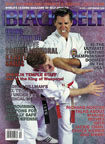
Radford University martial arts professor Jerry Beasley (philosophy '73; M.A. sociology; Ed.D) is featured on the cover of the September issue of Black Belt Magazine. Beasley's article in the issue solves a martial arts puzzle left 25 years ago by the late Bruce Lee.
Before his death Lee proposed a revolutionary martial arts philosophy that left more questions than answers. Asking his followers to "liberate themselves" from the traditional bounds of karate, Lee revealed his philosophy in vague references to "formlessness" and "the way is no way."
After 17 years of research, two published books, and numerous magazine articles, Beasley thinks he understands what Lee was trying to say. By "no way" Lee actually meant "no single way," Beasley says. All forms of martial arts can be incorporated into a style that suits an individual, he believes. These are controversial ideas in a field where strict discipline and a devotion to one method is the norm, says Beasley, admitting this theory is embraced by only 5 percent of martial arts practitioners.
Beasley has incorporated what he has learned about the "no way" philosophy into what he calls his "non-judgmental multicultural" martial arts program at Radford University and in the summer camps he leads for students from around the world.
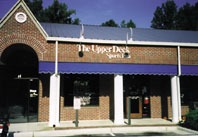
Go into most Blacksburg nightspots, and you'll find Hokie logos, posters, and probably some orange and maroon decor--after all, this is the home of Virginia Tech. Hokie fans find camaraderie all over town.
But in North Carolina, in N.C. State's backyard? The last thing you would expect to see in Cary, N.C., is a bar loaded with Virginia Tech memorabilia and a wide screen television showing Lane Stadium on a Saturday afternoon. But that is exactly what you'll find at the Upper Deck.
The place became a haven for the more than 2,000 Tech alumni living in the Research Triangle after former alumni association chapter president Ed Moore (industrial engineering '71) asked sports-bar owner Tom Kaznowski to air a Virginia Tech football game broadcast via satellite. "Kaz," as he is known by friends, was more than willing.
Soon Tech fans began donating Hokie pictures, jerseys, and logos to display at the Upper Deck. Then the alumni chapter arranged to have a large Tech sign join the ACC teams on the ceiling. On the wall is a framed letter from former Tech athletic director Dave Braine, thanking Kaznowski for working with the chapter to create a Hokie oasis.
Not surprisingly, Virginia Tech has the biggest college fan club in the area, 500 members strong, and when the Hokies play ball, at least 50 fans always show up at the Upper Deck.
"The fans are very loyal, and I will remain loyal to Virginia Tech," says Kaznowski, who televises football and basketball games. "They have first priority for our largest screens."
The Upper Deck is located at 329 N. Harrison Avenue, Cary, N.C.
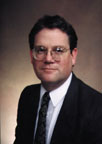 Treacy takes over at Virginia DEQ
Treacy takes over at Virginia DEQDennis Treacy (forestry and wildlife '78), director of the Virginia Department of Environmental Quality now heads the agency he entered as a co-op forestry student 20 years ago. After serving as interim director several months, Treacy was appointed in June to permanently replace the late Tom Hopkins as the agency's head.
Treacy holds a degree in environmental law and has served as a Virginia assistant attorney general dealing with natural resources issues. Treacy has held earlier government positions in West Virginia and was a lobbyist for Browning-Ferris Industries, one of the nation's largest solid-waste disposal companies.
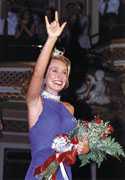 Heather N. Davis (communication '96), the newly crowned Miss Maryland, will be using her title to increase the visibility of her campaign against drug use by young people.
Heather N. Davis (communication '96), the newly crowned Miss Maryland, will be using her title to increase the visibility of her campaign against drug use by young people.
Seven years ago, as a senior at Annapolis Area Christian School, Davis created a drug awareness program that is still going strong. She called it LIFE: Loving Instruction for Elementary. The three-tiered program asks high school students to sign a contract agreeing not to use drugs, including alcohol and tobacco. These same students present anti-drug skits for area fifth graders, meet with them in one-on-one mentoring sessions, and begin pen pal relationships.
"The principals of the elementary schools keep asking us to come back. They think we are having an impact," she says.
The Maryland Board of Education has given the new Miss Maryland permission to create similar mentoring programs in at least one school in each of the state's 24 counties. Should she become Miss America, Davis hopes to give the LIFE program nationwide exposure.
Davis recently earned a master's in mass communication from Louisiana State University and plans to use her Miss Maryland scholarship money to pursue a doctorate in communication. Her goal is to teach.
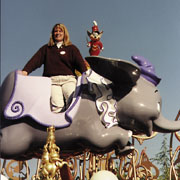
As one of four rides-systems engineers at Disneyland, Marlene Krpata (aerospace engineering '94) helped upgrade rides in Tommorrowland, the futuristic "land" within the theme park, which recently reopened amidst media fanfare.
Many of Tommorrowland's rides are over 40 years old. "It was like yesterday land," says Krpata, "so we went through re-theming to make it tomorrow land again."
Krpata helps maintain Rocket Rods, the newest attraction at Tommorrowland. Up to five people board a futuristic car that speeds over ramps and pops wheelies throughout Tommorrowland.
One of Krpata's favorite assignments was to redesign suspension technology of Fantasyland's Peter Pan ride, an original Disneyland attraction built in 1956. In this hanging ride, passengers "fly" through Never Never Land.
Krpata often works hand-in-hand with the Imagineers, the engineers who design Disneyland's rides from scratch. "This is basically the job I always wanted," she says.
Your student medical records from the Student Health Service are routinely destroyed 10 years after your graduation. If you need these records, please send a check for $7.50 by Nov. 1 to Paula Robertson, Virginia Tech Student Health, Henderson Hall, Blacksburg, VA 24061.
Back to Contents
Home | News | Features | Research | Philanthropy | President's Message | Athletics | Alumni | Classnotes | Editor's Page